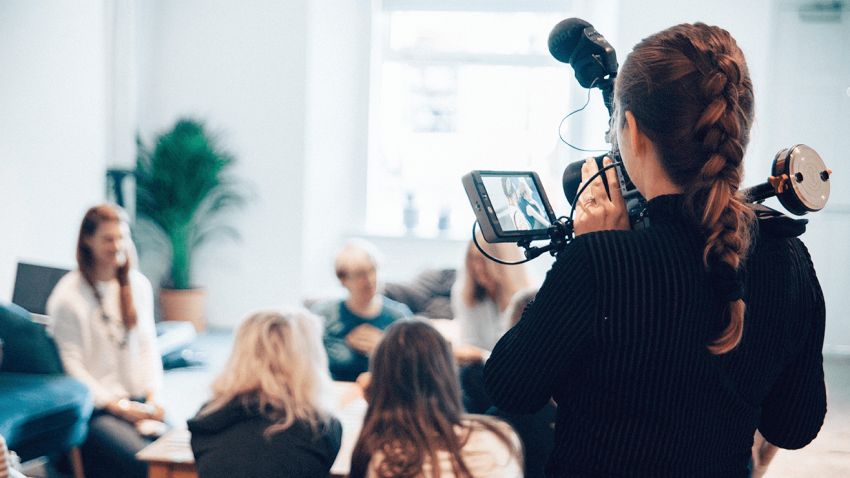Testimonials are a powerful way to encourage new customers and to build your brand identity. Yet they have to be done properly to be effective.
Testimonial videos that feel rote, generic, or coached aren’t going to inspire trust in your brand — quite the opposite. If you want to create testimonial videos that customers really listen to, you need to improve your techniques.
In this guest post from D-Mak Productions, we explore six trade secrets to producing compelling testimonial videos.
1. Prepare a list of questions beforehand — and make sure they’re the right ones.
To build a testimonial video, you first need to ask your customer questions. Your customer’s responses will build up the content of your video.
Asking the right questions is critically important. Give your customers something to go on, but don’t lead them too far. A testimonial has to be in their own words and their own voice.
Here are some open-ended questions you can ask that are neither too general nor too leading:
- What problems were you having that eventually led you to contact us?
- Which products and services were most interesting to you, and why?
- How did our product and service change the way that you do business?
- What were you concerned about when reviewing our product or service prior to purchase?
- What would you tell others who are considering our product or service?
- Was there anything that surprised you about our service?
- What made you the happiest about our service?
The key is to ask specific questions that inspire a conversation. Do some research on your subject beforehand to come up with unique questions that really get at their use-case or experience. Once you get the conversation flowing, you’ll have a much easier time getting the clips you need.
2. Structure your testimonial as a story
Your primary goal is to tell a story. All engaging videos have a storyline. In this situation, you’re telling a story through your customer. All stories have a beginning, middle, and end.
For a testimonial, the beginning is defined by their problem. What issues were they experiencing that led them to seek out your solution? What impact were these problems having on their life?
Next, you get to the middle part, which is the hunt for a good solution. How did they find our solution? What were their primary concerns moving forward? Did they buy your solution immediately, or did they need to think about it? Did they buy from someone else and have a less than desirable experience? Why did they ultimately decide to commit to your solution?
Finally, explore the ultimate impact your solution had on their problem. What were the things they expected — and what were the things that they didn’t expect?
For instance, in this example testimonial video for MDS Medical, we structured it to showcase the problems participants were facing upfront. As the video progresses, you get a clear sense for the value they ultimately received from attending the event.
Personalize the experience
All of the questions above seek to personalize the testimonial experience. They give your customer something to talk about, while also creating a frame for your customer’s story.
Don’t be afraid to ask additional questions as your testimonial video is shot. There may be some answers that you just didn’t expect or some things that you feel need a follow up. The more content you have when shooting your testimonial video, the better. It’ll give you more options when you’re editing it later on.
3. Scout out your location beforehand and choose wisely.
A testimonial takes a while to shoot. Find a brightly lit area that doesn’t have a lot of traffic or a lot of background noise. Practice shooting ahead of time, so you can figure out whether there may be any issues with the angle you’re shooting, or with the amount of noise from passersby. A bright, outdoor area is often preferred: it’s professional, lively, and engaging.
In this example, we filmed in several different locations for this testimonial video, which allowed us to give viewers a better sense of the entire event.
We were able to set up and film different vantage points efficiently because we took the time to scout the locations ahead of time.
Of course you can always shoot at a customer’s business, or even your own business. Just make sure that the background isn’t cluttered and that your customer is comfortable.
Most of all, you want a setting that feels natural; don’t use green screens or any other visual or digital tricks, because it’ll make the entire video appear to be inauthentic.
When scouting a location, pay special attention to the time of day, and the amount of light that you’ll get; lighting is one of the most important aspects of a video production. If you need to, get the appropriate licenses and permits in advance. Always remember that just the day of week can radically alter how busy a location is.
4. Record in high quality or hire a professional video production company.
Your testimonial needs to seem authentic, but that doesn’t mean it can be shot on a cellphone. It’s important to invest in high quality recording equipment, which can be either purchased outright or rented by the day. The higher quality your shoot is, the more professional the end result will be. A professional testimonial video is going to feel as though it has far more authority.
There are some advantages to hiring a professional video company rather than attempting to shoot on your own. It can be less expensive; a professional video company has reduced overhead because they already own all of the relevant equipment and have staff standing by to assist.
A professional video company can also streamline the process of optimizing and editing your video, as they can do this all in-house from the shots they filmed. And, of course, you usually have as much control over the process as you’d like. You can advise the company regarding your vision for the testimonial as it is shot and edited.
Read this post for more on whether you should hire a production company or film it yourself.
5. Avoid “artificial” testimonial videos by engaging your customer without coaching them
What makes a testimonial feel artificial? Usually, it’s when it seems as though the subject is being fed their lines. Generally speaking, people will automatically lose interest in whatever they’re saying.
Common pitfalls for testimonial videos
There are a lot of reasons why testimonial videos might feel “coached.” Here are a few of the most common issues:
- Giving them a script. Even if the script is written based on the customer’s own words, its still going to sound stilted. Instead, have them talk to you as though you’re having a normal conversation.
- Running identical repeated takes. There’s a limit on how many takes you can run and still have your customer sound authentic. As you run multiple takes, try to vary your questions and approach. You may get different answers each time, some of which may be more exciting than others.
- Prepping them on what to say. Try not to tell your customers what to focus on, or what you want them to say. It’s easy for these talking points to become a common thread through testimonials. Eventually, it will seem as though all of your testimonials are coached. Additionally, it burdens your customer with something else they need to think about when shooting.
- Feeling overwhelmed. Sometimes a customer just feels overwhelmed by the process. After all, many people haven’t been in front of a professional video camera before. Try to distract them by talking to them one-on-one and easing them into the shoot. Let them know what they can expect in terms of what’s going to happen and which questions are going to be asked. Then, try to let everything else follow naturally.
Some preparation is OK
Make sure your client has a clear picture of the overall process well before the shoot, and then progress from there with the tips above. This will allow them to feel prepared without being coached.
For this testimonial video, we were able to obtain highly specific and valuable sound bites by asking open-ended questions. We did not coach the subjects, but rather gave them enough to go on to get the ball rolling.
You want their words to be as extemporaneous as possible, as these words are going to feel the most legitimate. If you’re writing all your testimonials yourself, they’ll likely all start sounding the same — they’ll sound like you.
6. Make sure you’ve actually met and exceeded customers expectations before having them film a testimonial.
Don’t ask a customer to film a testimonial and then ask them whether they were happy with your service. The truth is that most people just want to help out, and even if they thought your service was mediocre, they’ll still jump on board. Unfortunately, they won’t have the best or most engaging things to say.
Instead, make sure you’ve met or exceeded a customer’s expectations, and then ask them to film a testimonial. A customer who was truly blown away by your company is going to have unique, interesting things to say about your business, their expectations, and the end result.
Your goal is to find customers who truly want to champion your business. Ideally, customers who are excited about the products that you offer and who want to bring other customers in.
Choose your testimonial subjects very carefully. Look for customers who have already brought other customers on board through a referral program or word-of-mouth. They likely have good things to share about your business.
It can be tempting to bring anyone to a testimonial when you’re trying to build up your content. However, a single unique, insightful, and funny testimonial is going to be worth much more than a few bland, generic ones that don’t adequately convey how your company is different.
Difference is the key: any company can provide a product or service. The customer needs to know why they should choose your company.
Key Takeaways
Once you’ve been able to apply these techniques, you should be able to get natural sounding, engaging, and exciting testimonial videos for your prospective customers.
Ultimately, remember:
- Authenticity matters more than anything else. Make sure your customers are truly excited and able to convey that in their own words.
- After authenticity comes quality. Film your testimonials with professional-grade equipment or hire a professional to do so.
- After quality comes preparation. By reviewing your questions, site, and equipment beforehand, you can reduce any risks.
Have a question about putting together a compelling testimonial video? Get expert advice in the comments below.








